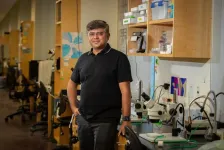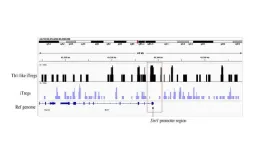(Press-News.org) Walleye are one of the most sought-after species in freshwater sportfishing, a delicacy on Midwestern menus and a critically important part of the culture of many Indigenous communities. They are also struggling to survive in the warming waters of the Midwestern United States and Canada.
According to a new study published Feb. 26 in the journal Limnology and Oceanography Letters, part of the problem is that walleye are creatures of habit, and the seasons — especially winter — are changing so fast that this iconic species of freshwater fish can’t keep up.
The timing of walleye spawning — when the fish mate and lay their eggs — has historically been tied to the thawing of frozen lakes each spring, says the study’s lead author, Martha Barta, a research technician at the University of Wisconsin–Madison. Now, due to our changing climate, walleye have been “unable to keep up with increasingly early and more variable ice-off dates,” Barta says.
Within a few days of ice-off, when a lakes’ frozen lid has melted away, walleye begin laying eggs and fertilizing them. In a normal year, that timing sets baby fish up for success once they hatch. But, Barta says, “climate change is interrupting the historical pairing of ice-off and walleye spawning, and that threatens the persistence of walleye populations across the Upper Midwest.”
Barta — who began working on the study as an undergraduate student at UW–Madison’s Center for Limnology — and her colleagues used data from walleye surveys from various state natural resource departments and the Great Lakes Indian Fish & Wildlife Commission, as well as the spring harvest counts from Ojibwe tribal nations to track the fate of walleye populations on 194 lakes across Minnesota, Wisconsin and Michigan. The data revealed “mismatches” in ice-off and spawning on almost every single lake. While there has been a slight shift to earlier spring spawning dates for walleye, the ice-off dates on those lakes were shifting at a rate of three times faster.
Suddenly, the timing is all wrong for walleye, explains Zach Feiner, a fisheries scientist with both the UW–Madison Center for Limnology and the Wisconsin Department of Natural Resources.
“In an average ice-off year, you have this nice progression of events,” Feiner says. “The ice goes off, you get light and warmer water that creates a bloom of small plant life called phytoplankton. And then tiny animals called zooplankton emerge and eat the phytoplankton, and usually, the walleye spawning is timed for them to hatch when zooplankton are around in high abundance and can serve as fish food for the baby walleye.”
But lately, the timing of yearly thaws has gotten “weird,” says Feiner. Lakes are, on average, thawing earlier, but the number of winters where lakes thaw late is also increasing. The shifts throw off the timing of phytoplankton blooms, zooplankton emergence and walleye hatch, breaking their linked progression as winter transitions to spring.
“When the fish hatch, there aren’t enough zooplankton around, and walleye don’t have enough food to survive,” Feiner says.
On a year-to-year basis, that isn’t necessarily a problem, as adult walleye can always spawn again the next year, when conditions may be more favorable and more of their offspring can survive and increase the population. But, Feiner says, the heightened variability of spring thaws is “increasing the frequency of bust years, and we’re not seeing many or any boom years for a lot of walleye populations.”
While this is obviously bad news for walleye and the people who depend on them, the study underscores the need to identify and protect lakes that can offer refuge in bad years.
“There is a need now to find places where, through management of things we can control — like land use, fish harvest and invasive species — we can buffer or boost their resiliency to be able to handle stuff we can’t control, like climate change,” Feiner says
If fisheries managers can identify lakes where walleye populations are doing relatively well, they can try to keep conditions optimal so that the fish can take advantage during the increasingly rare years when ice-off and their spring spawn do line up.
Then there is also the question of what our “weird” winters mean for other fish species.
“Most of our big-time sportfish species in the Midwest, like walleye, perch, pike, bass, bluegill and muskies, spawn in springtime,” Feiner says. Other species like lake trout and whitefish spawn in the fall, and their eggs overwinter under the ice.
Feiner hopes to expand the research to see if a pattern extends to other fish prized by people — or if some of them are resilient to less-predictable ice-off timing.
###
— Adam Hinterthuer, hinterthuer@wisc.edu
END
Walleye struggle with changes to timing of spring thaw
2024-02-27
ELSE PRESS RELEASES FROM THIS DATE:
New UC Berkeley-led study reveals widen gap on racial inequality in higher education
2024-02-27
A UC Berkeley-led study revealed that disparities in the share of Black and Latino students admitted to America’s elite colleges and universities have endured and even widened over the last 40 years.
The study, "Shifting Tides: The Evolution of Racial Inequality in Higher Education from the 1980s through the 2010s,"(link is external) was published this month in Sage Journals and conducted by a team of researchers from UC Berkeley’s Social Sciences D-Lab, SUNY Polytechnic Institute, University of Arizona and Portland State University. It used four national survey datasets to examine college attendance trends across ...
New study links placental oxygen levels to fetal brain development
2024-02-27
A new study shows oxygenation levels in the placenta, formed during the last three months of fetal development, are an important predictor of cortical growth (development of the outermost layer of the brain or cerebral cortex) and is likely a predictor of childhood cognition and behaviour.
“Many factors can disrupt healthy brain development in utero, and this study demonstrates the placenta is a crucial mediator between maternal health and fetal brain health,” said Emma Duerden, Canada Research Chair in Neuroscience & Learning Disorders ...
Long-term survivors of childhood cancer at higher risk of death following heart issues; threshold for treating risk factors should be lower
2024-02-27
New research out of VCU Massey Comprehensive Cancer Center and VCU Health Pauley Heart Center indicates that survivors of childhood cancer are at a significantly higher risk of death following a major cardiovascular event — including heart failure, heart attack or stroke — than the general public.
The findings – published this week in the Journal of the American College of Cardiology — could fuel advocacy for a paradigm shift in clinical heart health guidelines to address cardiovascular risk factors at an earlier age in childhood cancer survivors.
“We found that the risk of death after a major cardiovascular event in a 50-year-old in the general population ...
Study finds pesticide use linked to Parkinson’s in rocky mountain, great plains region
2024-02-27
EMBARGOED FOR RELEASE UNTIL 4 P.M. ET, TUESDAY, FEBRUARY 27, 2024
MINNEAPOLIS – Pesticides and herbicides used in farming have been linked to Parkinson’s disease in the Rocky Mountain and Great Plains region of the country, according to a preliminary study released today, February 27, 2024, that will be presented at the American Academy of Neurology’s 76th Annual Meeting taking place April 13–18, 2024, in person in Denver and online.
“We used geographic methods to examine the rates ...
Researchers make precious headway into a genetic form of Alzheimer’s disease
2024-02-27
(Santa Barbara, Calif.) — UC Santa Barbara researchers and collaborators in Colombia, Brazil and Germany are progressing toward an understanding of mechanisms that underlie Alzheimer’s disease, in particular an early-onset, genetic form that has afflicted generations of an extended family in Colombia. They also shed some light on a woman from that family who managed to beat the odds.
“What are the chances,” said UCSB neuroscientist Kenneth S. Kosik, a senior author of a paper that appears in the journal Neuron. “It’s unbelievable serendipity.”
It all takes place in the ...
CBD shown to ease anxiety without the risks that can come with THC
2024-02-27
Cannabis products high in the nonintoxicating compound CBD can quell anxiety better than THC-dominant products— and without the potential side effects, new University of Colorado Boulder research suggests.
The study of 300 people, published in the journal Cannabis and Cannabinoid Research, is the first randomized trial to examine how legal, commercially available cannabis impacts anxiety symptoms.
The study comes as one in five U.S. adults suffer from an anxiety disorder, making it the most common mental illness in the country, and prescriptions for anti-anxiety medications are on the rise.
“We ...
Sniffing our way to better health
2024-02-27
RIVERSIDE, Calif. -- Imagine if we could inhale scents that delay the onset of cancer, inflammation, or neurodegenerative disease. Researchers at the University of California, Riverside, are poised to bring this futuristic technology closer to reality.
In lab experiments, a team led by Anandasankar Ray, a professor of molecular, cell and systems biology, exposed the fruit fly (Drosophila melanogaster) to diacetyl, a microbial volatile compound released by yeast, and found changes in gene expression in the fly’s antennae in just a few days. In separate experiments, ...
Texas Tech and TTUHSC professors honored as NAI senior members
2024-02-27
The National Academy of Inventors (NAI) has announced four faculty members from the Texas Tech University System as part of the 2024 class of Senior Members.
Noureddine Abidi and Seshadri Ramkumar, both professors at Texas Tech University; Annelise Nguyen, associate dean for research at the School of Veterinary Medicine in Amarillo; and Hongjun (Henry) Liang, a professor from Texas Tech University Health Sciences Center (TTUHSC), join 120 other emerging academic inventors in this year’s class.
“These individuals are great representatives of the innovative spirit here at Texas Tech and are highly deserving of this recognition,” ...
UMass Amherst researchers identify enzyme key to training cells to fight autoimmune disorders
2024-02-27
Februay 27, 2024
UMass Amherst Researchers ID Enzyme Key to Training Cells to Fight Autoimmune Disorders
Discovery of new signaling pathway in immune cells may lay the foundation for drug-free, side-effect-free treatments for patients with aplastic anemia and other autoimmune disorders
AMHERST, Mass. – Researchers at the University of Massachusetts Amherst recently released a first-of-its-kind study that focuses on the rare autoimmune disorder aplastic anemia to understand how a subset of cells might be trained to correct the overzealous immune response that can lead to fatal autoimmune disorders. The research, published in Frontiers in Immunology, ...
Addressing societal concerns of genetic determinism of human behavior by linking environmental influences and genetic research
2024-02-27
It has long been known that there is a complex interplay between genetic factors and environmental influences in shaping behavior. Recently it has been found that genes governing behavior in the brain operate within flexible and contextually responsive regulatory networks. However, conventional genome-wide association studies (GWAS) often overlook this complexity, particularly in humans where controlling environmental variables poses challenges.
In a new perspective article publishing February 27th in the open-access journal PLOS Biology ...





